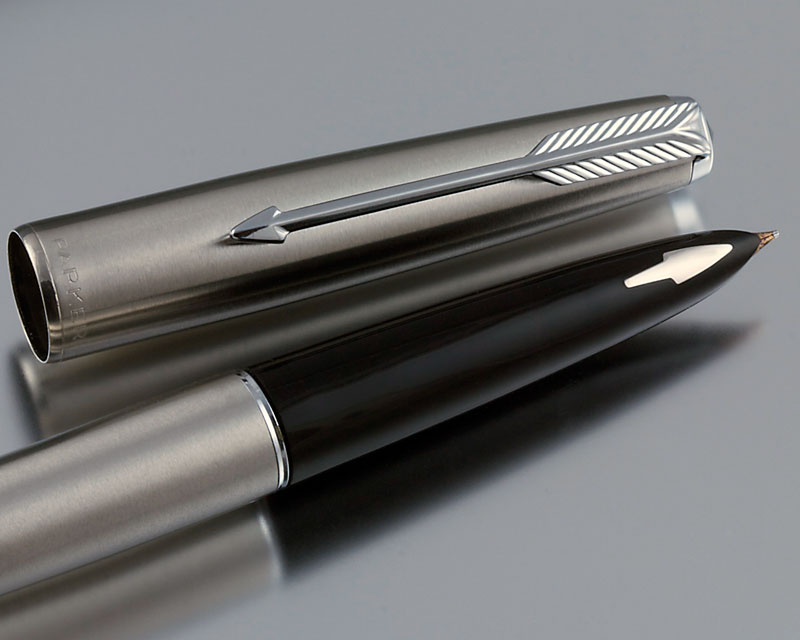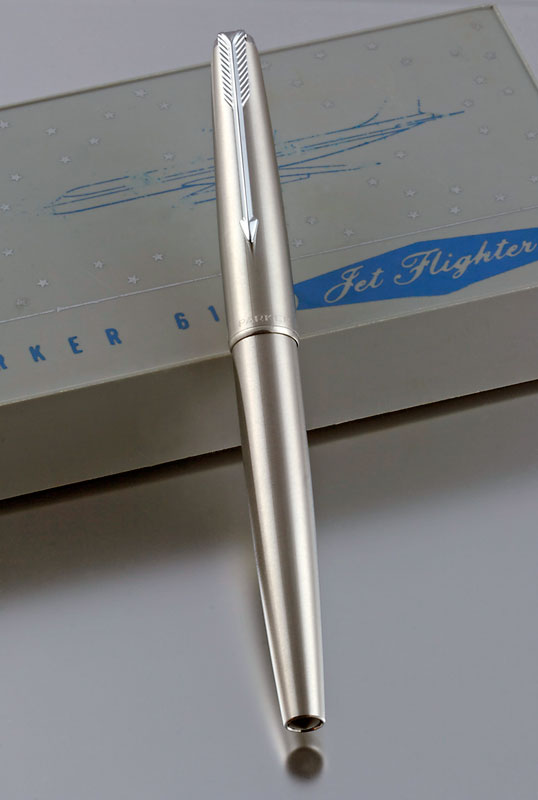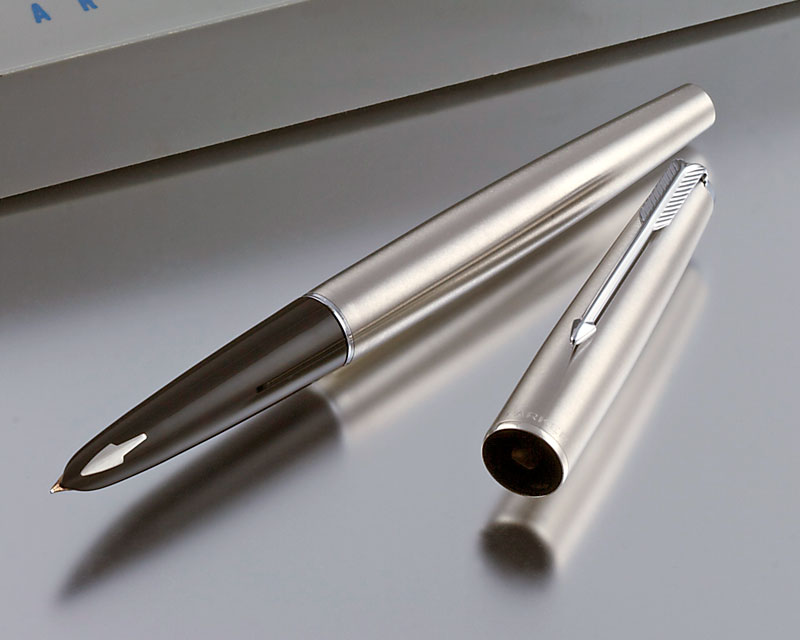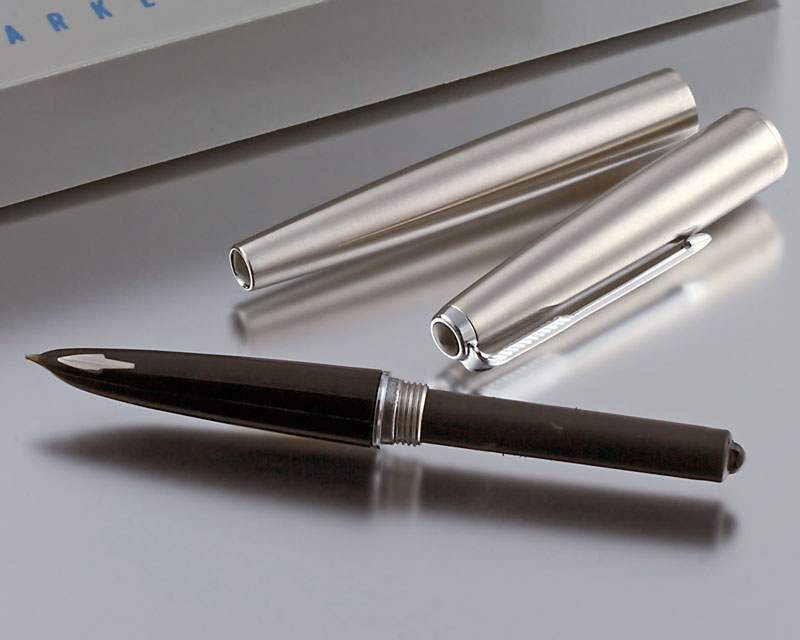PenHero 365: Parker 61 Jet Flighter
by Jim Mamoulides, January 29, 2010

Parker 61 Jet Flighter cap and nib detail
With the fountain pen losing more and more ground competing with the ballpoint, fountain pen manufacturers such as Parker spent the 1950s not only working on ballpoint pens but also working on designs that would make fountain pens easier and cleaner to fill. The Sheaffer Snorkel, introduced in 1952, demonstrated that a pen could fill from a bottle without wiping. Cartridge pens introduced by Waterman and Sheaffer in the mid 1950s showed that fountain pens could be refilled as easily and as cleanly as a ballpoint.
Probably the simplest successful filling system ever introduced debuted on the Parker 61 in 1956. Unlike any successful pen before or since, the Parker 61 uses no moving parts in order to fill the pen. The filling "cartridge" is permanently attached to the pen and draws ink by inserting the base of the cartridge into the inkwell. Inside the filling unit is a rolled, thin perforated polyethylene sheet. The base of the filling unit has three cutouts that allow the ink to enter it. The unit fills by wicking ink through capillary action, in the same manner that water can be drawn up a cotton thread by dipping one end. Surface tension holds the ink inside the filling unit until it is drawn to the nib. The outside of the filling unit is Teflon coated, so ink will not stick to it when it is removed from the inkwell, making the filling activity simple and clean. Parker illustrated this in advertisements showing the pen's nib unit sitting point up in an ink bottle with a person watching it, waiting for it to fill. Parker's advertisements described it as, "Unlike any pen in this world . . . or any other," and as a "new kind of pen that fills itself by itself."
Parker introduced the 61 Jet Flighter model in 1959 in all brushed stainless steel "Lustraloy" with chrome plated trim and fitted with a 14 karat gold hooded nib unit. The 61 Jet Flighter is more angular, more tapered, and narrower than its 51 predecessor. Both the cap top and barrel end of the 61 Jet Flighter are fitted with gray plastic "jewels." The model was produced through 1972.

Parker Jet Flighter closed
This Parker 61 Jet Flighter is a standard length, very tapered, light weight pen, weighing 0.7 ounce and being 5 1/4 inches long with the cap on and 5 5/8 inches with the cap posted on the end of the barrel. Parker 61s post deeply and securely and I like the feel in the hand with the cap posted better than without. It's just a little too short without the cap on the end of the barrel.

Parker 61 Jet Flighter open
The capillary filling system makes the Parker 61 a very convenient pen to use. Just as in the 1950s advertisements, I unscrew the barrel, drop the nib section into the ink bottle back end first and wait. Usually after 30 seconds the pen is filled and ready to write. If the outside of the filling unit is not scratched up or scarred, you won't even need to wipe it when inserted back into the barrel, as the Teflon coating really does drop the ink right back into the inkwell. Take care, as the base of the filling unit can let a drop or two go if the nib section is not handled carefully.
One tricky thing about Parker 61s is that if you find one that has been used but never flushed, it may not fill correctly, due to dried ink clogging up the capillary unit. This is fairly easy to fix, but you will need a bulb unit, like a baster has, though with a much smaller opening. These can sometimes be found in kits at pharmacies. The cleaning method is to insert the filling unit into the bulb and squeeze water into and out of the pen until it flushes clear. If the pen is not badly clogged it may also be primed by dipping the nib into the ink for a few seconds allowing the front end of the feed to wet.

Parker 61 Jet Flighter open showing capillary filling unit
As with a Parker 51, writing with the Parker 61 is not about gazing at a fancy nib, it's about a reliable pen that writes well. The brushed stainless steel finish on the 61 is duller than on the 51 and the pen is much more slender. It's a good fit in the hand if you like a smaller pen. The nibs on all the 61s I have tried are a little more dry writing than the 51, which means writing takes a little more effort.
The Parker 61 had a long run, from 1956 through 1983, and many different models were made, from lustraloy cap and plastic barrel models to high end solid gold pens. A collector focusing on the 61 will have his work cut out for him both in terms of capturing all the types and in terms of the hit on your wallet. Parker 61s made after 1969 are cartridge / converter pens, adding another dimension to the line. My preference is the capillary type, both from a user and a collector point of view. These are really high quality pens that should please the collector and the user.
Discuss / Recommend what you read on PenHero.com
Follow us on Twitter: PenHero
Add a link to PenHero.com on your blog:
(Copy & paste code)
Please only use the photo provided. Use of other photos requires permission.
The provided link photo will change as we update the site.
Comments on this article may be sent
to the author, Jim Mamoulides
PenHero.com Bibliography
